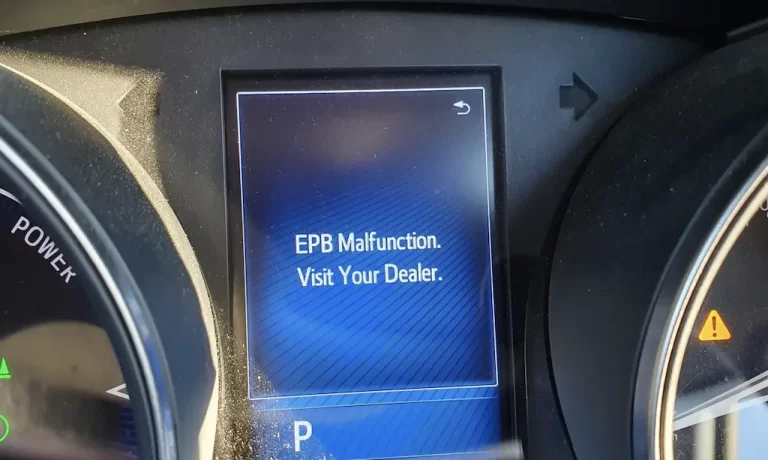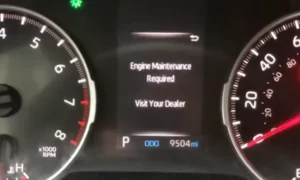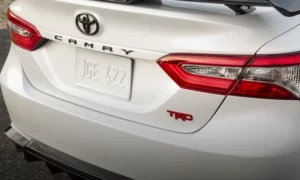Having your Toyota display an “EPB Malfunction” warning can be frustrating and concerning. This electronic parking brake issue affects various Toyota models including the Camry, Corolla, RAV4, and C-HR. But don’t worry – most EPB problems have straightforward solutions once you understand what’s happening. This guide walks you through the causes, diagnosis, and fixes for Toyota EPB malfunctions.
What is the Toyota Electronic Parking Brake?
The Electronic Parking Brake (EPB) in your Toyota replaces the traditional handbrake lever with an electronic button system. When you press the EPB button, electric actuators engage the rear brake calipers to hold your vehicle in place.
Modern Toyota EPB systems include convenient features like:
- Automatic engagement when shifting to Park
- Automatic release when accelerating
- Brake Hold function for temporary stops
While these features make driving easier, the system’s electronic complexity can sometimes lead to malfunctions.
Most Common Causes of Toyota EPB Malfunctions
Weak Battery – The #1 Culprit
A weak or failing battery is the most frequent cause of EPB errors in Toyotas. The system requires stable 12V power to operate the brake actuators. When battery voltage drops below 11.5V, you’ll often see the dreaded “EPB Malfunction” message.
Signs your battery is causing the EPB issue:
- Warning appears after your car sits unused for days
- Other electrical systems act sluggish
- Warning clears after a jump start or battery charge
The fix? Charge or replace your battery. Most EPB warnings disappear instantly once proper voltage is restored.
Actuator and Motor Failures
The EPB’s caliper actuators can wear out or fail mechanically. Problems include:
- Stripped internal gears
- Motor burnout
- Sensor malfunctions
These issues typically generate diagnostic codes like C060B49 (Left Actuator Internal Failure) or C061049 (Right Actuator Internal Failure). Unfortunately, actuator failures usually require replacement parts, costing between $1,200-$2,000 per caliper if your vehicle is out of warranty.
Software Glitches and Calibration Errors
The EPB system is computer-controlled, making it susceptible to software bugs. These can include:
- False detection of overcurrent conditions
- Calibration mismatches
- ECU memory failures
The 2020-2021 Toyota Corolla and RAV4 models experienced significant software issues with their EPB systems, generating code C059746 (Calibration Memory Failure). Toyota released official software updates to fix these problems.
Wiring and Connector Problems
Electrical gremlins can also trigger EPB warnings:
- Damaged wiring harnesses
- Corroded connectors
- Faulty wheel speed sensors
These issues often appear as intermittent EPB malfunctions, especially after driving over bumps or in wet conditions. Some Toyota owners have reported fixing EPB problems by simply cleaning or reconnecting actuator wiring.
How to Diagnose a Toyota EPB Malfunction
Check for Diagnostic Trouble Codes (DTCs)
When your Toyota displays an EPB Malfunction message, the system stores specific error codes that can identify the exact problem. Common EPB-related DTCs include:
- C059704: Internal ECU failure
- C060962: Parking brake switch signal mismatch
- C13B800: General actuator malfunction
While dealerships use the Toyota Techstream diagnostic tool, you can access these codes with many aftermarket OBD2 scanners that support Toyota’s specific protocols.
Perform a Manual Reset
For minor EPB glitches, a simple reset procedure might clear the warning:
- Turn the ignition ON (without starting the engine)
- Press and hold the EPB button for 10-15 seconds
- Restart the vehicle and test functionality
This procedure works for temporary electronic hiccups but won’t fix mechanical problems or serious electrical issues.
Test Your Battery
Since battery issues are the most common EPB problem cause, testing battery voltage should be your first step:
- Use a multimeter to check voltage (should read 12.4-12.7V when off)
- Check voltage while running (should read 13.7-14.7V)
- Have your battery load-tested if it’s more than 3 years old
A battery can appear to have sufficient voltage when measured at rest but still fail under the load of operating the EPB motors.
Toyota EPB Malfunction: Model-Specific Issues
Toyota RAV4 EPB Problems
Recent RAV4 models (2019-present) have experienced several common EPB issues:
- Software calibration errors in 2019-2020 models
- Actuator failures in higher-mileage vehicles
- False warnings triggered by low battery voltage
Toyota released a software update for the RAV4 that addresses many of these concerns. If your RAV4 shows EPB warnings, check if your vehicle falls under any active recalls or service bulletins.
Toyota Corolla EPB Malfunctions
The Corolla’s EPB system from 2020 onwards has shown several patterns:
- Calibration Memory Failure (code C059746) is particularly common
- Software updates are usually required to resolve issues
- Actuator failures typically occur at higher mileage
Toyota Australia even issued a recall for Corolla Cross models in 2023 due to EPB software flaws that could cause intermittent failures.
Toyota Tundra EPB Issues
The 2022-2023 Tundra models were subject to recall 23TC06 addressing EPB malfunctions caused by software errors. These errors would falsely trigger failsafe modes, creating EPB warnings. The fix involved a dealer-performed update to the skid control ECU software.
DIY Solutions for Toyota EPB Malfunctions
Battery Maintenance to Prevent EPB Problems
Since battery issues cause most EPB warnings, regular battery maintenance can prevent problems:
- Clean battery terminals to ensure good connections
- Test battery voltage every 6 months
- Replace batteries older than 3-5 years proactively
- Consider a battery tender for vehicles that sit unused
This preventative approach can save you from unexpected EPB warnings and potential towing expenses.
Using Toyota EPB Service Mode for Brake Work
If you’re replacing brake pads or rotors on a Toyota with EPB, you must use Service Mode to avoid damaging the system:
- With ignition ON, press the brake pedal
- Pull and release the EPB button 3 times
- Push and release the button 3 times
- Hold the button down until actuators retract
This sequence fully disengages the electric actuators, allowing safe brake service. Skipping this step has caused many DIYers to damage their EPB systems during brake jobs.
Emergency Manual Release Procedure
If your EPB won’t disengage and you need to move the vehicle:
- Remove the small access panel near the EPB button
- Locate the manual release cable
- Pull the cable firmly while applying brake pressure
- Release slowly to avoid sudden vehicle movement
This emergency procedure varies by model – check your owner’s manual for the exact location of the release mechanism in your specific Toyota.
Toyota EPB Recall and Technical Service Bulletin Information
Toyota has issued several EPB-related recalls and service bulletins worth checking:
| Model Years | Models Affected | Recall/TSB Number | Issue |
|---|---|---|---|
| 2022-2023 | Tundra | 23TC06 | Software errors triggering false EPB warnings |
| 2023 | Corolla Cross | Toyota Australia Recall | Software flaw causing intermittent EPB failures |
| 2020-2021 | Corolla, RAV4 | T-SB-0078-21 | ECU calibration errors (code C059746) |
Always check if your vehicle falls under any of these campaigns by entering your VIN on Toyota’s recall lookup page or the NHTSA website.
Real Owner Experiences with Toyota EPB Malfunctions
Case Study: 2018 Toyota C-HR Intermittent Failure
A Toyota C-HR owner reported on Reddit that their EPB warning would appear after driving over bumps. After multiple dealer visits, a technician discovered a corroded connector at the left actuator. A simple harness replacement resolved the issue that had puzzled mechanics for weeks.
Case Study: 2019 Lexus RX350 Post-Brake Service Error
After replacing rear brake pads without enabling Service Mode, an RX350 owner faced persistent EPB warnings. Using a VXDIAG VCX Nano tool with Toyota Techstream software, they reset the system at home, avoiding a $450 dealership fee.
Preventative Maintenance Best Practices
To minimize the risk of EPB malfunctions:
- Monitor battery health: Regularly test voltage and replace aging batteries
- Ensure software is current: Check for available ECU updates during service visits
- Use proper brake service procedures: Always activate Service Mode before rear brake work
- Avoid forceful releases: Don’t manually disengage the EPB without pressing the brake pedal
Following these practices can significantly reduce your chances of experiencing EPB problems.
Understanding Your Toyota EPB Warning Messages
Different warning messages can indicate specific problems:
| Warning Message | Likely Meaning |
|---|---|
| “EPB Malfunction” | General system error – could be battery, actuators, or ECU |
| “EPB Malfunction Visit Your Dealer” | More serious issue requiring professional diagnosis |
| “Release Parking Brake” | EPB is engaged but you’re attempting to drive |
| “Parking Brake Unavailable” | System has entered failsafe mode |
The vehicle’s behavior also provides clues:
- If the brake engages automatically when it shouldn’t, suspect software issues
- If it won’t release despite proper battery voltage, suspect mechanical problems
- If warnings come and go, look for electrical connection issues
The Future of Toyota EPB Technology
Toyota continues to refine its EPB systems, with newer models showing improved reliability. Future developments may include:
- Integration with advanced driver assistance systems
- Enhanced self-diagnostic capabilities
- More robust fail-safe mechanisms
- Simplified service procedures for technicians
These improvements aim to address the reliability concerns seen in earlier EPB implementations while adding new convenience features.
Toyota’s shift to electronic parking brakes represents the broader industry trend toward replacing mechanical systems with electronic ones. While this adds convenience features, it also introduces new complexity and potential failure points. Understanding how your Toyota’s EPB works and the common issues it might face can save you time, money, and frustration when problems arise.














